THIS WEEK'S SKY AT A GLANCE, FEBRUARY 10 – 19BY: ALAN MACROBERT FEBRUARY 10, 2023  1 1
GET ARTICLES LIKE THIS SENT TO YOUR INBOX
Email (required) *
Constant Contact Use.
14
Comet ZTF is fading and receding into the distance. On the other hand, it's now conveniently placed high overhead in early evening in a moonless sky; the waning Moon doesn't rise until late. The comet is crossing Auriga and Taurus on its way toward Orion's shield. It peaked in brightness on February 1st at about magnitude 5.0. As of February 9th it was down to about 6.1. That evening, using 10 x 50 binoculars under a mediocre suburban sky, I could just detect it near Iota Aurigae as a vague, diffuse enhancement of the sky background. Averted vision helped.
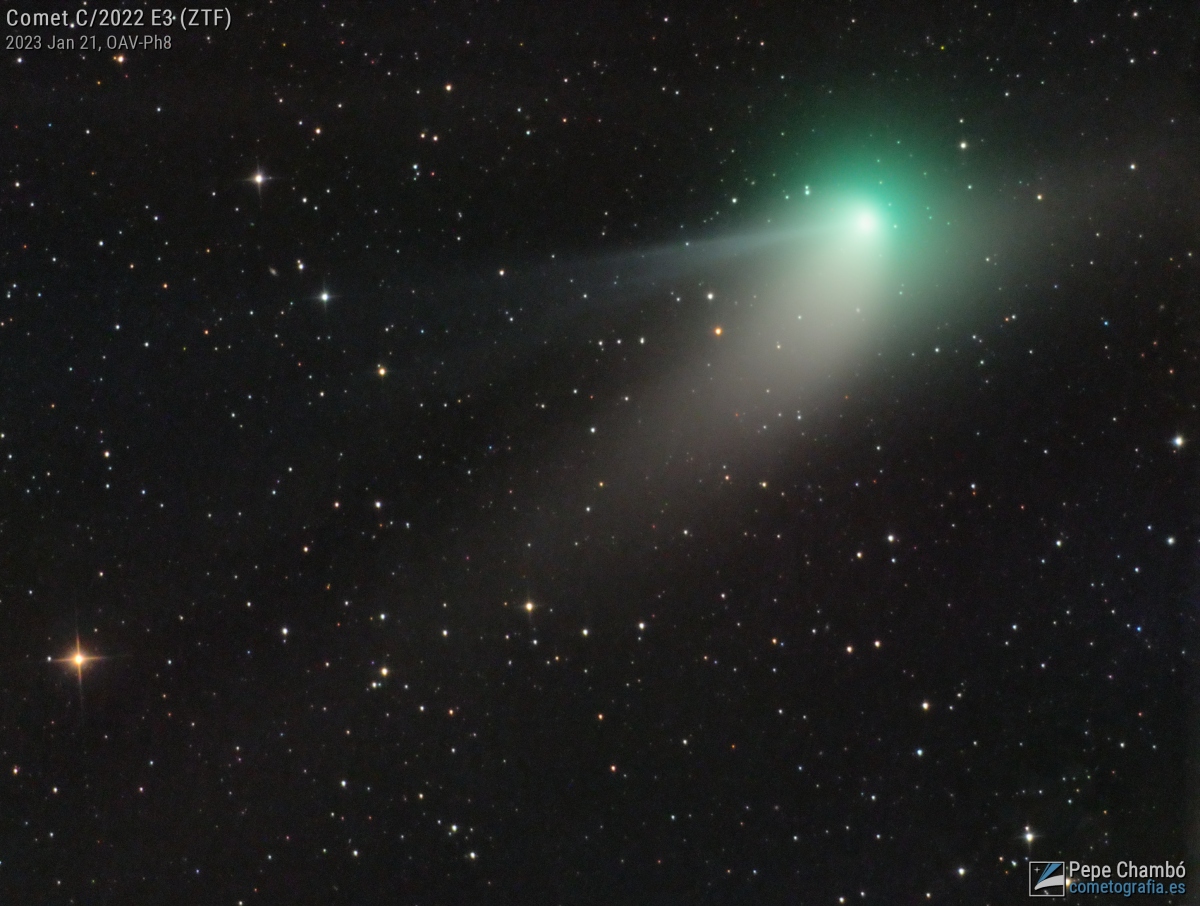 Comet ZTF E3, imaged on January 21st by Pepe Chambó of Valencia, Spain, using an 8-inch short-focus reflector. Note the narrow, straight ion tail and the broad, curved dust tail. Don't confuse long-exposure, stacked and processed images of a dim, diffuse object like this with its appearance to the eye, even in the same telescope!The comet is heading south after its swing past the Little Dipper in late January. Bob King's new article Understanding the Tails of Comet ZTF has a finder chart to use in February. (On that chart, the comet symbols are labeled with the dates for evenings in North America, not the UT dates.) Comet ZTF E3, imaged on January 21st by Pepe Chambó of Valencia, Spain, using an 8-inch short-focus reflector. Note the narrow, straight ion tail and the broad, curved dust tail. Don't confuse long-exposure, stacked and processed images of a dim, diffuse object like this with its appearance to the eye, even in the same telescope!The comet is heading south after its swing past the Little Dipper in late January. Bob King's new article Understanding the Tails of Comet ZTF has a finder chart to use in February. (On that chart, the comet symbols are labeled with the dates for evenings in North America, not the UT dates.)
When the comet becomes too faint for that chart to suffice, use the more detailed one in the February Sky & Telescope, page 48 (where the dates are for 0:00 UT; subtract one day from those to get the North American civil date).
On the evenings of February 10th and 11th the comet will be less than 2° from bright Mars. By then it will probably be about mag 6.4, which is some 300 times fainter than Mars. And of course the comet's light is much more spread out ("diffuse").
It should be down to 7.5 by February 17th.
FRIDAY, FEBRUARY 10
¦ Sirius the Dog Star blazes in the southeast after dinnertime, below Orion. It's the brightest star of Canis Major. In a dark sky with lots of stars visible, the constellation's points can be connected to form a convincing Big Dog profile. He's currently standing on his hind legs. Sirius is on his chest, to the right or lower right of his faint triangular head.
But through the light pollution under which most of us live, only his five brightest stars are easily visible. These form the Meat Cleaver. Sirius is the cleaver's top back corner, its blade faces right, and its short handle is down below pointing lower left.
¦ Comet ZTF passes Mars this evening and tomorrow evening. Although the comet has dimmed to about magnitude 6.3, binoculars should still show it if you have a good dark sky. The Moon doesn't rise until about 10 or 11 p.m.
Right after the end of twilight, face south and look very high, almost overhead. The comet is 1.6° upper left of Mars, at the top of the "s" in "Mars" in the diagram below (for evening in North America). Tomorrow evening, Saturday, the comet will be 1.8° below Mars.
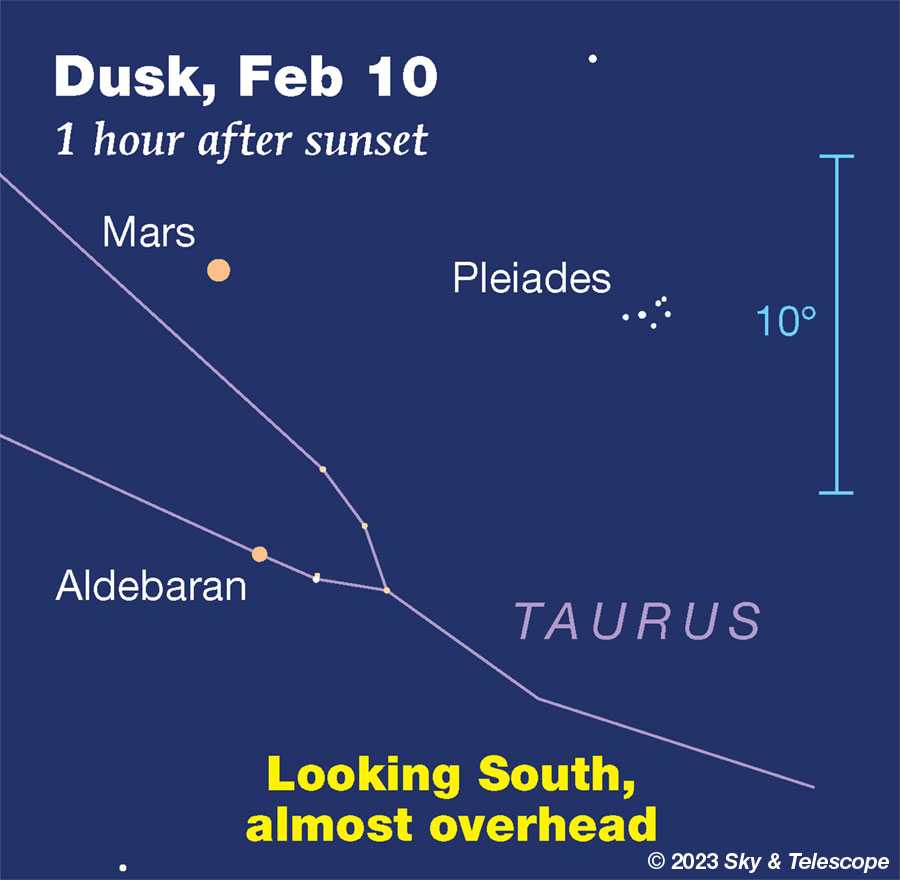 This is the naked-eye setting for faint Comet ZTF as it passes Mars on Friday the 10th and Saturday the 11th; see the text. This is the naked-eye setting for faint Comet ZTF as it passes Mars on Friday the 10th and Saturday the 11th; see the text.
The orientation of this scene changes as the night grows late. The whole array will seem to rotate clockwise as it moves lower toward the west. ¦ The waning gibbous Moon rises late Friday night, with 1st-magnitude Spica about 3° to its right or lower right as shown below.
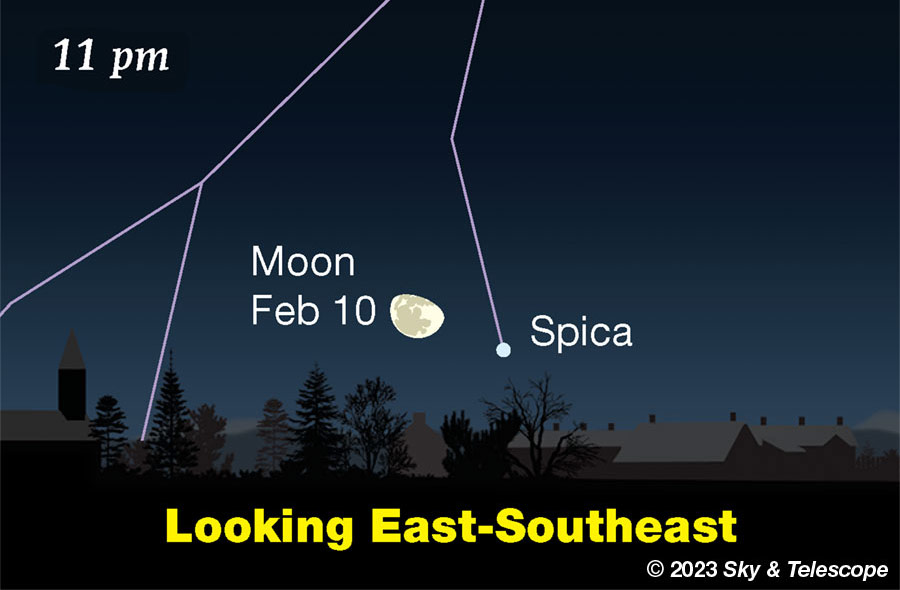 The eerie waning gibbous Moon, with 1st-magnitude Spica, clears the east-southeast horizon around 11 p.m. Friday depending on your location. SATURDAY, FEBRUARY 11 The eerie waning gibbous Moon, with 1st-magnitude Spica, clears the east-southeast horizon around 11 p.m. Friday depending on your location. SATURDAY, FEBRUARY 11
¦ Right after nightfall this week, the W of Cassiopeia shines high in the northwest standing almost on end.
The brightest star between Cassiopeia and the zenith right after dark, as seen from the world's mid-northern latitudes, is Alpha Persei (Mirfak), magnitude 1.8. It lies on the lower-right edge of the Alpha Persei Cluster: a large, elongated, very loose scatter of fainter stars about the size of your thumbtip at arm's length. At least a dozen are 6th magnitude or brighter. They show best in binoculars. Some of them form a distinctive curving arc focused on Alpha Persei.
Alpha Per, a white supergiant, is a true member of the group and by far its brightest light. It and the rest are about 560 light-years away.
SUNDAY, FEBRUARY 12
¦ High in the northern sky these evenings, in the seemingly empty wastes between Capella overhead and Polaris due north, sprawls big, dim Camelopardalis, the Giraffe — perhaps the biggest often-visible constellation you don't know. Unless you have a really dark sky, you'll need binoculars to work out its loose, faint, nondescript pattern using the constellation chart in the center of Sky & Telescope — a challenge project that will build your skills for correctly relating what you see in binoculars to what you see, much smaller, on a sky map.
If you're new at this, start with brighter, easier constellations and save the shy Giraffe until you get good at it.
MONDAY, FEBRUARY 13
¦ Last-quarter Moon, exactly so at 11:01 a.m. today. But the Moon doesn't rise until late tonight, around 2 a.m., in the head of Scorpius. By the time Tuesday's dawn begins it's high in the south-southeast and already slightly less than half lit, as shown below.
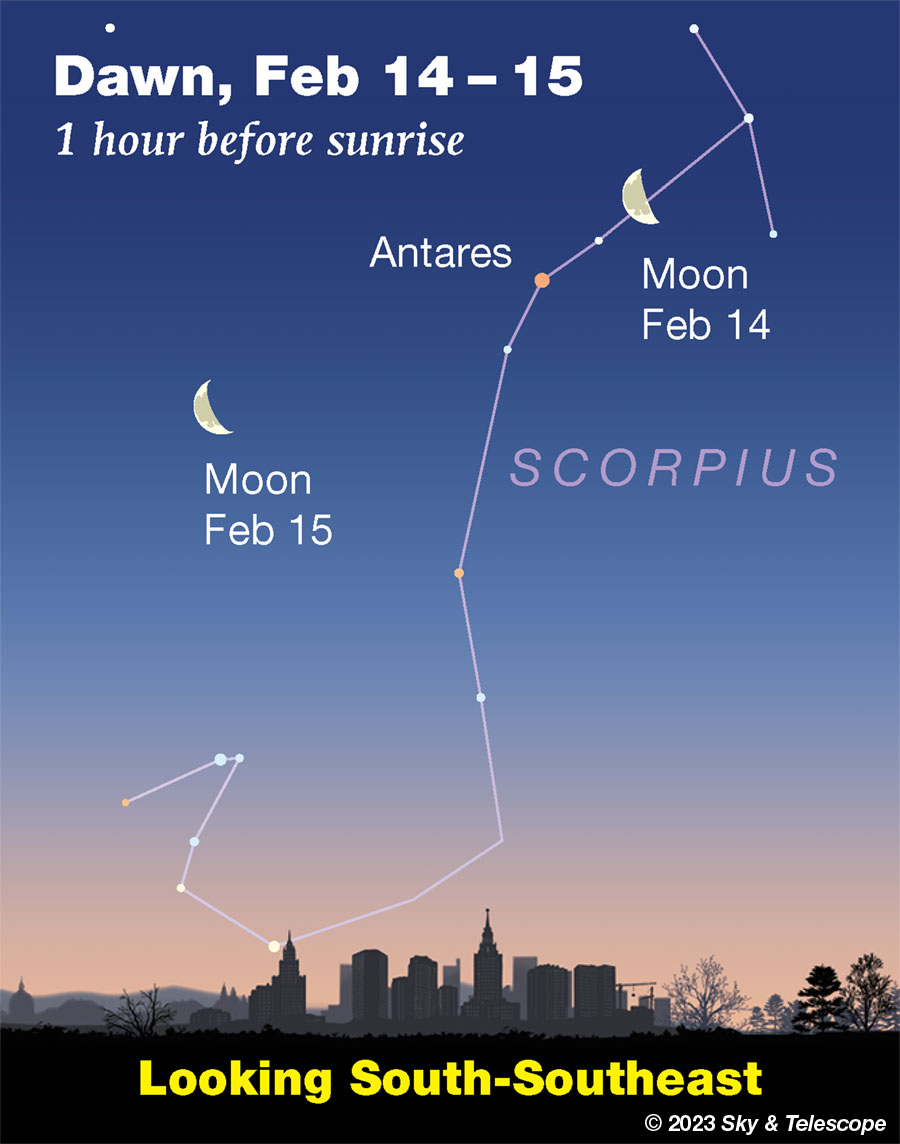 Before and during early dawn Tuesday morning, the waning Moon shines in the head of Scorpius just about halfway between Antares and Delta Scorpii.¦ Algol should be at its minimum brightness, magnitude 3.4 instead if its usual 2.1, for a couple hours Monday night centered on 11:02 p.m. EST; 8:02 p.m. PST. Algol takes several additional hours to fade and to rebrighten. Before and during early dawn Tuesday morning, the waning Moon shines in the head of Scorpius just about halfway between Antares and Delta Scorpii.¦ Algol should be at its minimum brightness, magnitude 3.4 instead if its usual 2.1, for a couple hours Monday night centered on 11:02 p.m. EST; 8:02 p.m. PST. Algol takes several additional hours to fade and to rebrighten.
TUESDAY, FEBRUARY 14
¦ After it’s good and dark, look due east, not very high, for twinkly Regulus. Extending upper left from it is the dimmer Sickle of Leo, a backward question mark. "Leo announces spring," goes an old saying. Actually, Leo showing up in the evening announces the cold, sloggy back half of winter. Come spring, Leo will already be high.
WEDNESDAY, FEBRUARY 15
¦ Spot the big, bright, equilateral Winter Triangle in the south-southeast. Sirius is its brightest and lowest star. Betelgeuse is above Sirius by about two fists at arm's length. To their left shines Procyon.
Can you discern their colors? Sirius (spectral type A0) is cold white, Betelgeuse (M2) is yellow-orange, and Procyon (F5) is white with just a slight touch of yellow.
¦ The inside of the Winter Triangle is mostly filled by the front half of Monoceros, the dim Unicorn. It always trots across the sky behind Orion. With the Moon out of the evening sky, now's a fine time to trace out the Unicorn's big, dim stick figure. Use the constellation chart in the center of the February or March Sky & Telescope.
Many binocular starwatchers know about its distinctive star cluster NGC 2244, a boxy little rectangular pattern in the center of the vastly dimmer Rosette Nebula. It's right about where the Unicorn's eye might be in his triangular head. The brightest stars of the box pattern are 6th and 7th magnitude. Find them 10° to the celestial east-southeast of Betelgeuse. The elongated rectangle currently stands upright.
If you've got big binoculars or a small telescope, try next for the larger but fainter Christmas Tree Cluster, NGC 2264, at 15 Monocerotis: the 5th-magnitude star marking the tip of the Unicorn's horn above the back of his head. The stars outlining the Christmas Tree are only 7th and 8th magnitude. The tree currently hangs downward from its base, marked by 15 Mon. See Matt Wedel's Binocular Highlight column and map in the February 2022 issue of Sky & Telescope, page 43.
THURSDAY, FEBRUARY 16
¦ Orion stands his highest in the south by 7 or 8 p.m., looking smaller than you probably remember him appearing early in the winter when he was low. You're seeing the "Moon illusion" effect. Constellations, not just the Moon, tend to look bigger when they're low and smaller when they're high.
Under Orion's feet, and to the right of Sirius now, hides Lepus the Hare. Like Gemini and Canis Major, this is a constellation with a connect-the-dots that really looks like what it's supposed to be. He's a crouching bunny, with his nose pointing lower right, his faint ears extending up toward Rigel (Orion's brighter foot), and his body bunched to the left. His brightest two stars, 3rd-magnitude Alpha and Beta Leporis, form the back and front of his neck.
¦ Algol should be at its minimum for a couple hours centered on 7:51 p.m. EST.
FRIDAY, FEBRUARY 17
¦ Jupiter and Venus are closing in on each other in the western twilight, as shown below. They're on their way to a head-turning conjunction on March 1st. That evening they'll be ½° apart and lined up horizontally. Mark your calendar.
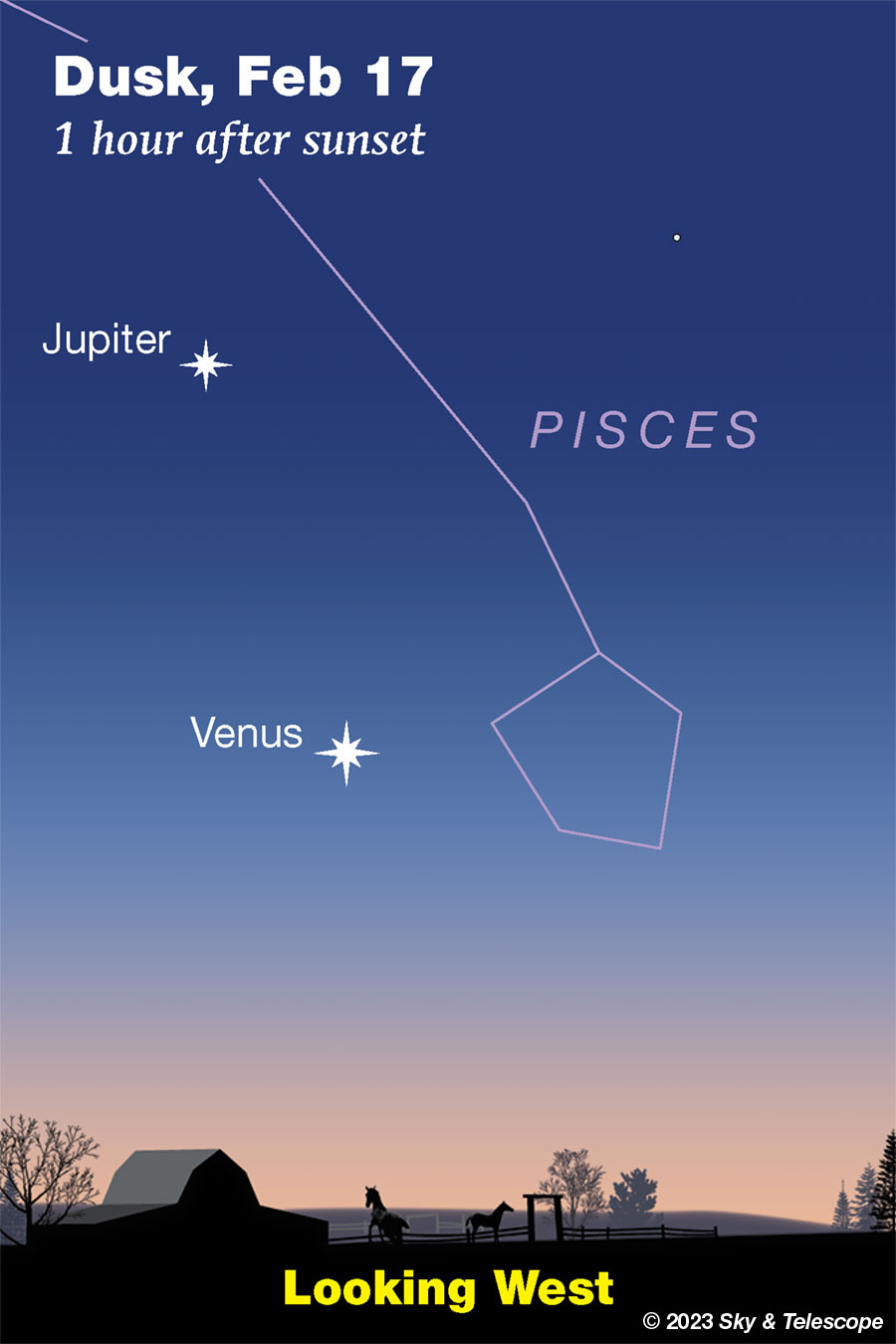 The two brightest planets are becoming ever more of an eye-catcher in the dusk as they draw closer together day by day.SATURDAY, FEBRUARY 18 The two brightest planets are becoming ever more of an eye-catcher in the dusk as they draw closer together day by day.SATURDAY, FEBRUARY 18
¦ By 9 p.m. or so, the Big Dipper stands on its handle well up in the northeast. In the northwest, Cassiopeia also stands on end (its brighter end) at about the same height. Between them is Polaris.
SUNDAY, FEBRUARY 19
¦ Have you ever seen Canopus, the second-brightest star after Sirius? Canopus lies almost due south of Sirius: by 36°. That's far enough south that it never appears above your horizon unless you're below latitude 37° N (southern Virginia, southern Missouri, central California). And there, you'll need a very flat south horizon. Canopus crosses the south point on the horizon just 21 minutes before Sirius does.
When to look? You'll know Canopus is due south when Beta Canis Majoris — Murzim the Announcer, the star about three finger-widths to the right of Sirius — is at its highest due south over your landscape. That's about 8 p.m. now, depending on how far east or west you are in your time zone. Drop straight down from Murzim then. |





 1
1
 This is the naked-eye setting for faint Comet ZTF as it passes Mars on Friday the 10th and Saturday the 11th; see the text.
This is the naked-eye setting for faint Comet ZTF as it passes Mars on Friday the 10th and Saturday the 11th; see the text. The eerie waning gibbous Moon, with 1st-magnitude Spica, clears the east-southeast horizon around 11 p.m. Friday depending on your location. SATURDAY, FEBRUARY 11
The eerie waning gibbous Moon, with 1st-magnitude Spica, clears the east-southeast horizon around 11 p.m. Friday depending on your location. SATURDAY, FEBRUARY 11 Before and during early dawn Tuesday morning, the waning Moon shines in the head of Scorpius just about halfway between Antares and Delta Scorpii.¦
Before and during early dawn Tuesday morning, the waning Moon shines in the head of Scorpius just about halfway between Antares and Delta Scorpii.¦  The two brightest planets are becoming ever more of an eye-catcher in the dusk as they draw closer together day by day.SATURDAY, FEBRUARY 18
The two brightest planets are becoming ever more of an eye-catcher in the dusk as they draw closer together day by day.SATURDAY, FEBRUARY 18